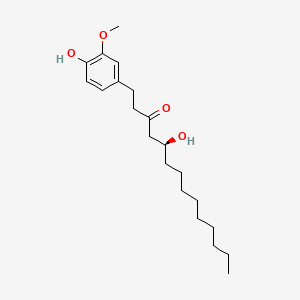(6)-gingerol, 10-gingerol, 6-gingerol, gingerol



| Name | 10-Gingerol | ||
| PubChem CID | 168115 | ||
| Molecular Weight | 350.5g/mol | ||
| Synonyms |
(6)-gingerol, 10-gingerol, 6-gingerol, gingerol |
||
| Formula | C₂₁H₃₄O₄ | ||
| SMILES | CCCCCCCCCC(CC(=O)CCC1=CC(=C(C=C1)O)OC)O | ||
| InChI | 1S/C21H34O4/c1-3-4-5-6-7-8-9-10-18(22)16-19(23)13-11-17-12-14-20(24)21(15-17)25-2/h12,14-15,18,22,24H,3-11,13,16H2,1-2H3/t18-/m0/s1 | ||
| InChIKey | AIULWNKTYPZYAN-SFHVURJKSA-N | ||
| CAS Number | 23513-15-7 | ||
| ChEMBL ID | CHEMBL549472 | ||
| ChEBI ID | CHEBI:81134 | ||
| KEGG ID | C17496 | ||
| Toxicity | Organism | Test Type | Route(Dose) |
| rat | LD50 | intraperitoneal(165 mg/kg) | |
| mouse | LD50 | intraperitoneal(254 mg/kg) | |
| rat | LD50 | oral(322 mg/kg) | |
| Structure | 
|
Download
2D
MOL
3D
MOL
|
|
| Chineses Pinyin | ShengJiang | ||
| Use Part | Rhizome, Cork, Leaf | ||
| Habitat | SiChuan, GuiZhou, HuBei, GuangDong, GuangXi | ||
| Flavor | Pungent | ||
| Meridian Tropism | Lung, Spleen, Stomach | ||
| Species |
>Kingdom: Viridiplantae
-->Phylum: Streptophyta
-->Class: Equisetopsida
-->Order: Zingiberales
-->Family: Zingiberaceae
-->Genus: Zingiber
-->Species: Zingiber officinale
|
||
| Pair Name | 10-Gingerol, Paclitaxel | |||
| Partner Name | Paclitaxel | |||
| Disease Info | [ICD-11: 2C60] | Breast cancer | Investigative | |
| Gene Regulation | Down-regulation | Expression | ADRB2 | hsa154 |
| Down-regulation | Expression | BCL2 | hsa596 | |
| Up-regulation | Expression | BAX | hsa581 | |
| Up-regulation | Cleavage | PARP1 | hsa142 | |
| Down-regulation | Expression | MAPK1 | hsa5594 | |
| In Vitro Model | MDA-MB-231 | Breast adenocarcinoma | Homo sapiens (Human) | CVCL_0062 |
| SUM159PT | Breast pleomorphic carcinoma | Homo sapiens (Human) | CVCL_5423 | |
| In Vivo Model | Human MDA-MB-231 cells (cell density: 5×10⁶ / 200 μL PBS) were injected into the breast fat pad of each mouse. | |||
| Result | This data suggests that 10-G may be used as a new chemotherapeutic synergist in combination with paclitaxel to enhance anticancer activity. The potential value of ADRB2 as a target for improving chemotherapy sensitivity was also emphasized. | |||
| Pair Name | 10-Gingerol, Doxorubicin | |||
| Partner Name | Doxorubicin | |||
| Disease Info | [ICD-11: 2C60] | Breast cancer | Investigative | |
| Biological Phenomena | Inhibition-->Cell metastasis | |||
| Gene Regulation | Down-regulation | Expression | CDK1 | hsa983 |
| Down-regulation | Expression | CDK2 | hsa1017 | |
| Down-regulation | Expression | CDK4 | hsa1019 | |
| Down-regulation | Expression | CDK6 | hsa1021 | |
| Up-regulation | Activity | CASP3 | hsa836 | |
| Up-regulation | Expression | H2AX | hsa3014 | |
| In Vitro Model | 4T1 | Malignant neoplasms of the mouse mammary gland | Mus musculus (Mouse) | CVCL_0125 |
| In Vivo Model | 1×10⁶ human MDA-MB-231 HMTL.6 cells were injected into the inguinal mammary fat pad of Balb/c congenic athymic nude mice (40 µl/mouse in 50% matrigel, n = 6). | |||
| Result | Our data indicate that [10]-gingerol has potential to be used as a neoadjuvant or in combined therapy with doxorubicin, to improve its anticancer activity. | |||
| No. | Title | Href |
|---|---|---|
| 1 | [10]-Gingerol improves doxorubicin anticancer activity and decreases its side effects in triple negative breast cancer models. Cell Oncol (Dordr). 2020 Oct;43(5):915-929. doi: 10.1007/s13402-020-00539-z. | Click |
| 2 | 10-Gingerol Enhances the Effect of Taxol in Triple-Negative Breast Cancer via Targeting ADRB2 Signaling. Drug Des Devel Ther. 2023 Jan 20;17:129-142. doi: 10.2147/DDDT.S390602. | Click |
